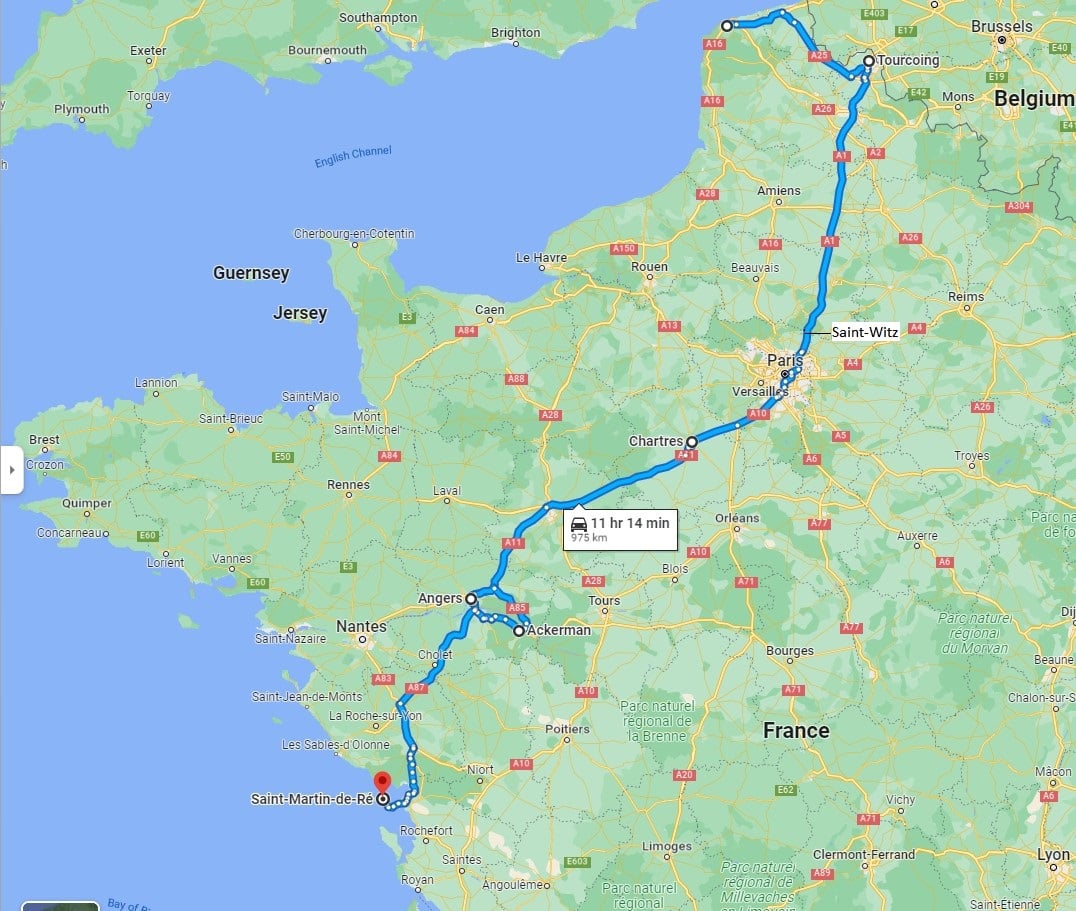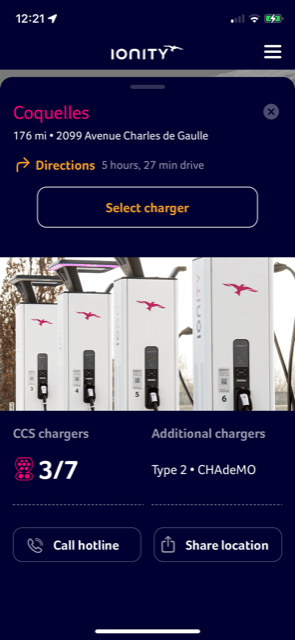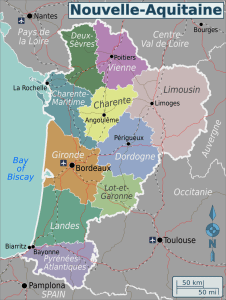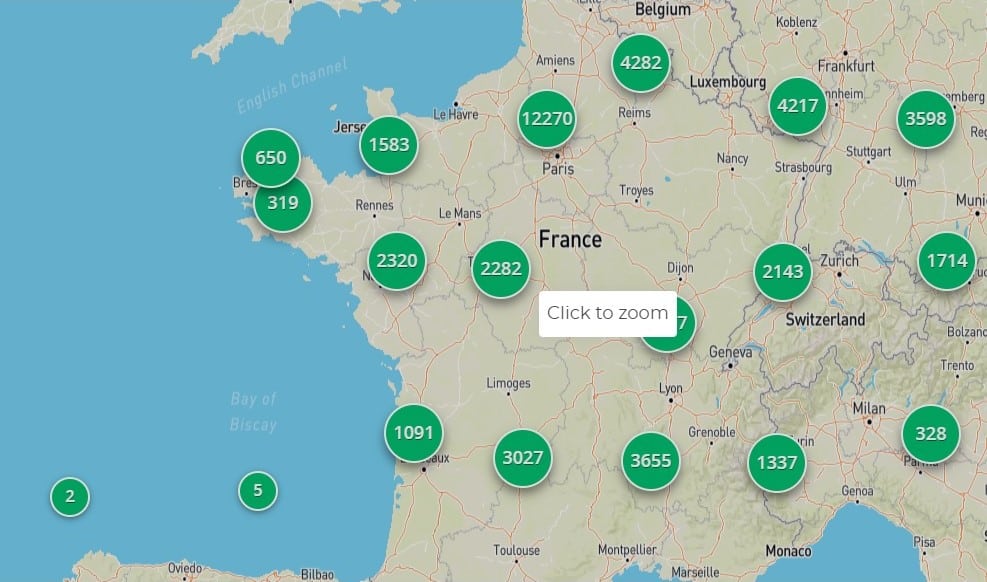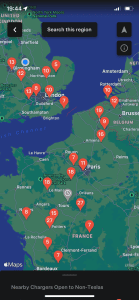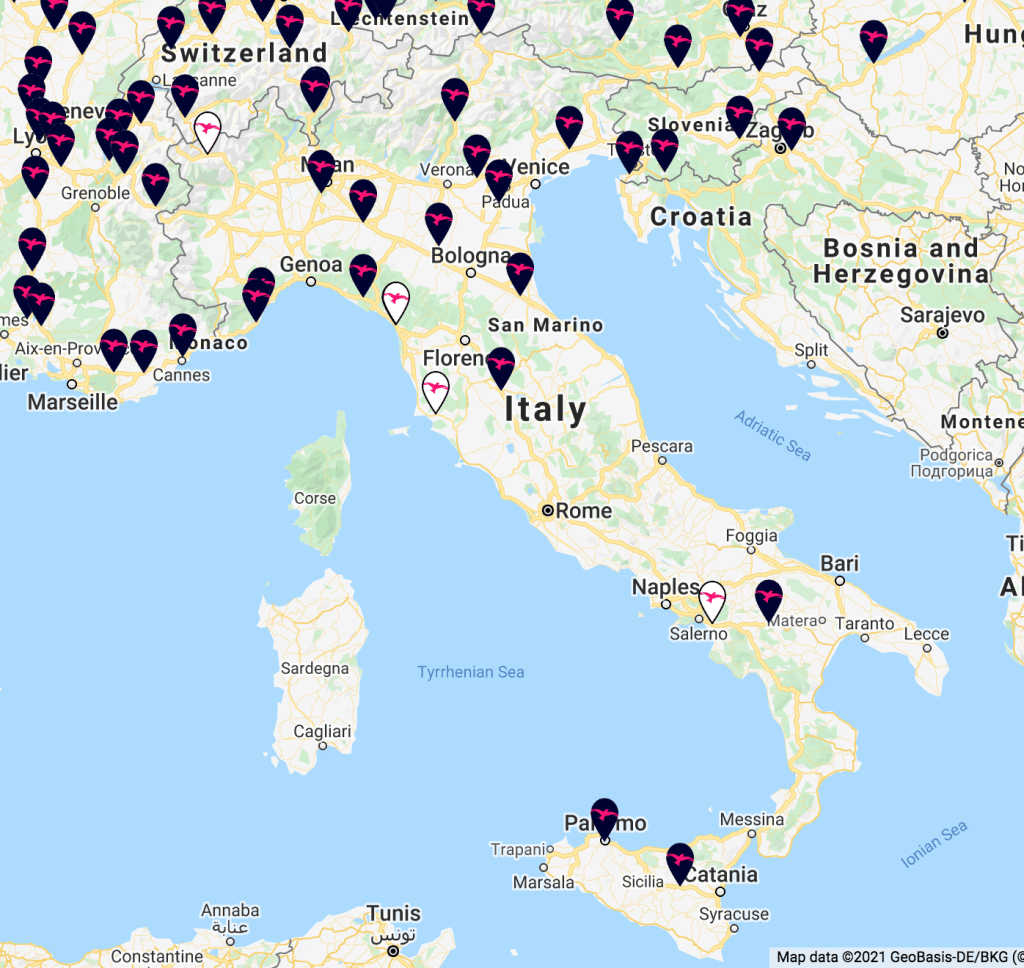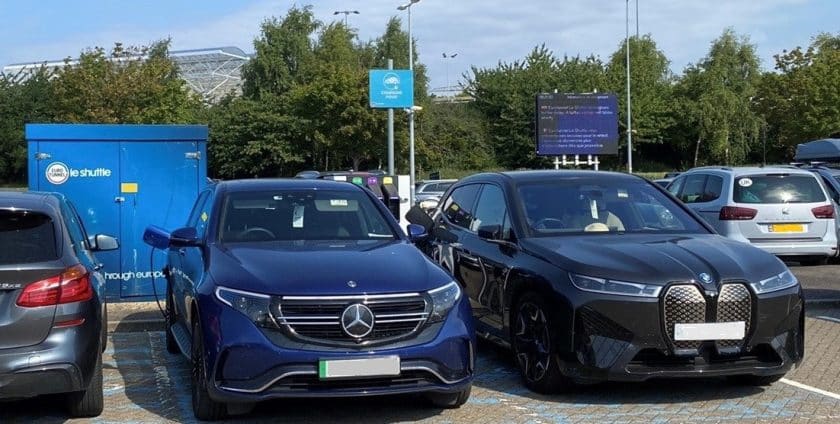
- By: admin
- 0 comment
5 Things to know when taking a Battery Electric Car to France
This blog has been largely superseded by my latest blog on the subject:
5 More things to know before you take a battery electric car to France
————+————
5 Things to know when taking a Battery Electric Car to France, follows on from my earlier blog, 5 Things I wish that I had known before I bought a Battery Electric Vehicle. In that I questioned the practicality of taking a battery electric car to France. This summer, that is what we did. Starting on the hottest day in the UK ever, we drove to an hotel just outside of Dover before taking the Tunnel the next day. We used the Tunnel partly because it offers charging points at the terminal. Unfortunately, the previous day’s record temperatures caused a build-up of heat in the tunnel, limiting the throughput of trains. However, the resulting three-hour delay did allow us to get a full charge at the terminal. Our route took us from Calais, north to Roublais, near Lille, for a business meeting, then south to Chartres where we stayed overnight. Angers was the next stop for two nights and another meeting. A side trip to Saumur was required to buy some of its excellent sparkling wine. The following day we left Angers and travelled to our final destination on the Île de Ré, near La Rochelle.
The return journey was via an overnight stop in Rouen, then through the Tunnel and home. So here are the “5 Things to know when taking a Battery Electric Car to France”.
1. There is a dearth of Rapid chargers in France
I will start by making this statement. On all but one occasion when we arrived at a rapid or ultra-rapid charger in France, there was a queue when we arrived and a queue when we left. Our first experience of this was the IONITY charger at Saint-Witz (7 charge points) some 15 km from the outskirts of Paris. According to the Belgian driver we chatted to,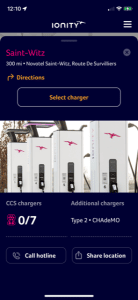
As I write this, I can see that there are currently no unoccupied chargers at the Saint-Witz site.
Oddly enough the only charge point we did not have to queue at was the one at Coquelles, next to the Calais end of the Channel Tunnel. Again, as I write there are 3 out of 7 chargers unoccupied there. Both ends of the Channel Tunnel have chargers, but on the day we left France, only the Tesla chargers were working.
This problem of chargers either not working or working sub-optimally was not uncommon. We arrived at one IONITY site to find that three of the chargers were either not working or only charging at 50kW instead of 150kW+. We had to call an international phone number to get them to reboot the chargers. This finally gave us a decent charge. Admittedly, this problem is not restricted to France, but there are more options in the UK.
2. Be prepared for Charger Rage
Most of the people we met when queueing for a charger were Belgian or Dutch, with the occasional Frenchman. As in the UK, we all chatted and there was an informal queueing system, which generally worked well. However, on one occasion someone jumped the queue in an aggressive manner. Unfortunately, they were French, but I am not making a cultural point here. A Dutch lady got very angry, and it would not be difficult to see how matters could have spiralled out of hand. I believe that as the number of battery electric vehicles increases, the likelihood of charger rage, perhaps leading to physical violence, will only increase. I recommend that you try to talk to those queuing and pre-empt any misunderstanding. For us this worked well, as most of those queuing at the rapid or ultra-rapid spoke decent English.
On our return to the UK we arrived at an IONITY charging point to find a member staff organising the queue. He was on a two-week assignment to elicit customer feedback, but quickly found himself managing the queue. This is not a practical solution long term, and I believe that a queuing system based on an App or an on-site booking system will be needed.
3. The Charging Sites may not be where you think they are
Not all Aires (Service areas) have chargers of any type. Some have charge points on the northbound side, but not on the southbound. This fact is not immediately obvious.
On one memorable occasion, when traveling south the sat-nav took us to a charging point that turned to be on the north bound service area. This involved coming off the Toll-road, incurring a fee. Then 50 metres later joining the northbound Toll-road to access the charging point in the Aire, which set up another fee. After charging, we had to head north for 12 km before exiting the Toll-road, only to immediately re-enter the toll road again, heading south for another 12km, before getting back to where we started. It was an expensive charge.
4. Apps are also important in France.
Many, if not most of you will have a RIFD card allowing you to charge at a number of public charging points. We have a Mercedesme ,card, which offers great coverage for rapid and ultra-rapid chargers. However, in cities or large towns in France, fast or slow chargers were usually the only ones available. These are the chargers that will require several hours, if not overnight to fully charge your car. Many did not accept our Mercedesme ,card. We found two local Apps to be useful, but different regions have other options.
MObiVE, which covers the Nouvelle-Aquitaine region, has an app on both the App Store and Google play.

It took a little time to install, but provided details of each of my charges, the locations their charge points and availability. We used it in Angers, but it also allowed access to several charge points on the Île de Ré.
There are similar regional suppliers, Ouest Charge Bretagne in Brittany, and Prise de Nice for Nice and the Côte d’Azur.
Both are available from the App Store and Google play. The Ouest Charge network also includes a number of other Departments in West and Northwest France, including Loire – Atlantique and the Vendée.
The other App we used was freshmile, which managed most of the rest of the charge points on the Île de Ré. It is also in widespread use across France.
Again, it provided details of each of my charges, the locations of their charge points and their availability. It also provided information on some third-party charge points.
I would advise setting up the apps before you go, rather than endure the stress of installing them at the charge point. These charge points also provide another benefit. You usually can avoid the need to pay for parking, even overnight parking, whilst using one.
For a general over view of chargers in France I would recommend Chargemap.
5. Sort out the Tesla App before Traveling
Tesla has opened up some of is chargers to non-Tesla EV drivers. France is one of the countries in which the trial is taking place. We discovered that the locations are quite limited (see image). Perhaps the most useful one for those traveling out to France, is the one at the Folkestone terminal of the Channel Tunnel. Many Tesla drivers are unaware of this change so, you may be challenged, sometimes forcefully. Unsurprisingly, the Tesla user group on Facebook is full of less than enthusiastic comments by Tesla drivers.
In order to use the available charge points you need to download the App and create a Tesla account. Make sure you down load the Tesla App with this logo.
Not the “Superchargers for Tesla App” with this logo. That one will not help you at all.
Use these links to get the right one.
I would add a payment method at this point. You do this by tapping the head and shoulders logo on the top right and then select Account then Wallet. I found Apple Pay preloaded. I have an iPhone so Android may be slightly different. To add a credit card, tap “Add” on the top right.
To charge, on the App select ‘Charge Your Non-Tesla’ and find a Supercharger site near your location. On reaching the site select a charger and plug in your car. Select the stall (Tesla call them stalls) and tap ‘Start Charging’. Select ‘Stop Charging’ to complete your session. I believe that you are limited to a 90 minutes session and after that they apply a fine. For full details follow the link to Non-Tesla Supercharger Pilot. As this is a pilot, my information may not be reliable in a few months’ time.
5 Things to know when taking a Battery Electric Car to France, final thoughts.
Taking a Battery Electric Vehicle on holiday to France was not the most relaxing way to travel. This was compounded because we were incorporating business meetings across France. From what the people I met told me, the situation is much better in Belgium, the Netherlands and particularly in Germany. We tried to plan our stops well in advance, but as a wise old general once declared “no plan survives contact with the enemy”. That was what it felt like in France.
One sign of hope is the announcements that both the French hypermarket chains E.Leclerc and Carrefour have started installing chargers in their carparks. Carrefour is promising to install “more than 2,000 fast charging points with outputs of between 75 and 300 kW at its so-called “hypermarkets” at more than 200 locations in France by 2023.”
One final point. Countries may claim many charging points, but for the traveller, it is the number and availability of rapid and ultra-rapid chargers that is the important figure.
We were told by a number of the people we met, “Don’t even think to of taking a Battery Electric Vehicle to Italy”. In the UK there are over 42,000 charging points. The latest figures I could find for Italy were from 2020 when there were only 12,150. In the same year France had nearly 25,000. The map below shows the number of IONITY chargers in March 2021, which says it better than I can.
Glen Winkfield
glenw@ghginsight.com
11th August 2022
© 2022 Sustainability Vision Ltd
Glen Winkfield is Marketing Director of Sustainability Vision Ltd. Through GHGi Analytics, its cloud-based solutions, the company provides tools for organisations to measure, analyse and report their GHG emissions. Also available is GHGi Commuting is solution covering employee commuting and homeworking. Sustainability Vision also offers help to organisations of all sizes, needing to develop a strategy to reach Net Zero.
